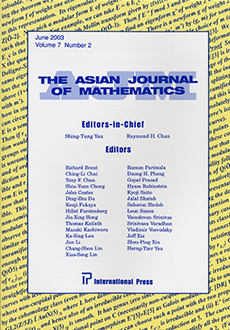Abstract
Let $X, Y \subset k^m(k = \mathbb{R},\mathbb{C})$ be smooth manifolds. We investigate the central symmetry of the configuration of $X$ and $Y$. For $p \in k^m$ we introduce a number $\mu(p)$ of pairs of points $x \in X$ and $y \in Y$ such that $p$ is the center of the interval $\overline{xy}$. We show that if $X, Y$ (including the case $X = Y$ ) are algebraic manifolds in a general position, then there is a closed (semi-algebraic) set $B \subset k^m$, called symmetry defect set of the $X$ and $Y$ configuration, such that the function $\mu$ is locally constant and not identically zero outside $B$. If $k = \mathbb{C}$, we estimate the number $\mu$ (in fact we compute it in many cases) and show that the symmetry defect is an algebraic hypersurface and consequently the function $\mu$ is constant and positive outside $B$. We also show that in the generic case the topological type of the symmetry defect set of a plane curve is constant, i.e. the symmetry defect sets for two generic curves of the same degree are homeomorphic (by the same method we can prove similar statement for any irreducible family of smooth varieties $Z^n \subset \mathbb{C}^{2n}$). Moreover, for $k = \mathbb{R}$, we estimate the number of connected components of the set $U = k^m \backslash B$. In the last section we give an algorithm to compute the symmetry defect set for complex smooth affine varieties in general position.
Citation
S. Janeczko. Z. Jelonek. M. A. S. Ruas. "Symmetry defect of algebraic varieties." Asian J. Math. 18 (3) 525 - 544, July 2014.
Information





